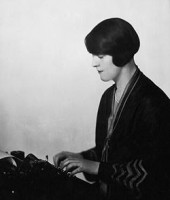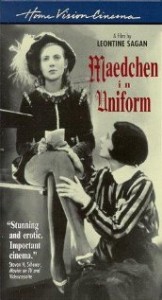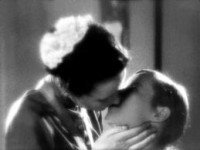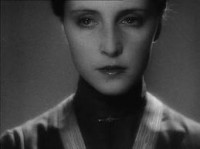Teacher’s pet, I wanna be teacher’s pet…
Mädchen in Uniform, one of the most important films of all time, is lesbionic. Made in 1931, it’s an artistic commentary on fascism and queer love. The movie is set in Prussia, and illuminates a young lady name Manuel, who is a new student at the world’s harshest all girl’s boarding school. On her first day, she is stripped of all her personal possessions and bullied into her appropriate place on the food chain.
There seems no respite for poor Manuel, until she examines the inside of her used school uniform. (Damn, every time I try to type “uniform”, I type “unicorn” instead.) On the label is written a simple initial, E.v.B. The seamstress smiles, and tells her that whoever owned the uniform prior, must have a crush on a teacher named Elizabeth von Bernburg. Foreshadowing! WoW!
The school is beyond strict, made on the tide on Nazism, it embodies all of the Nazi Youth ideals. The girls are starved into submission, and bombarded with creepy hymnals and nationalistic hoo-ha. The other school girls flurry around Manuel in an orderly fashion. Many of them involved in intimate, and physical relationships with each other. There’s a sweet scene of two girls cuddling and consoling each other. The teacher quickly breaks them apart.
Manuel can’t find her niche, and finds the stifling thumb of the school too much to bear. Elizabeth von Bernburg tunes into the suffering girl, and looks at her with more than just a compassionate eye. So, every night Bernburg gives every wanting girl a kiss goodnight on the forehead. The fervor that builds in each of them as she approaches is tangible. Their hormones are zipping about the room like swooping pterodactyls. Finally, it’s our hero’s turn, Bernburg can tell that Manuel needs more comforting than the other girls. She’s labled, “an emotional child”. So, instead of the usual goodnight kiss on the forehead, Bernburg goes in for the gold. It’s tense, provacative, and gives you that sinking feeling. The good times at Fatherland High cannot last.
A love affair between a teacher that is supposed to seem strict and unreachable, and a lost young girl who’s inner fires have just been stoked, isn’t going to end well. Bernburg, noticing the young orphan’s ragged petticoats, gives her a new one. She makes her promise not to tell the other girls, because they will be jealous. This is what happens when there’s only one out lesbian to go around. Can Manuel keep her devotion a secret? Can any young lady resist the “kiss and tell”?
Nope.
That’s enough plot for you. This movie inspired countless others. Loving Anabelle is known to take directly from Mädchen in Uniform. I did it again! I just typed Unicorn. Madchen in Unicorn would mean, Girls in Unicorns. That’s just not right. It also doesn’t provoke the fascist themes of this movie. Nazi’s and Unicorns are mortal enemies, because Nazi’s hate rainbows… they’re too diverse. In Madchen in Unicorn true loves run free on sparkling galloping hooves of wonder. SPARKLE!
This movie is based on a play written by Christa Winsloe. She was a lesbian herself, and said later that the character of Manuel was based on a girl with whom she went to school. There is a tragic bit at the end, but not at all what you think. What’s truly amazing, is this sad-ending love story did not end as morose as many of the works it inspired. In many movies after this, queer characters were punished for coming-out with death. You kissed a girl, and now a piano will fall on your head! Let’s just say that the girls at the school have Manuel’s back, and are there for her when she needs them most. I know that’s a bit of a spoiler, but it’s monumental that one of the first popular films with queer themes did NOT end up in suicide, or a disease of “justice”. I just threw up a little… into my party cup.

Dorothy Thompson, so interesting looking, and mortal enemy to the Nazi Party. Nazi Party just doesn't sound right either.
Christa Winsloe was known to date Dorothy Thompson. Dorothy was such an influential anti-Nazi reporter in WWII that Time Magazine called her one of two most important women in America. The other was Eleanor Roosevelt, who by no coincidence was responsible for lifting the ban on Mädchen in Uniform in the U.S.A..
The Nazis really really tried to destroy every copy of this movie. We’re very lucky it escaped Germany, and we get to look at it today. Winsloe worked against the Nazis to her dying day. She was murdered with her companion by Frenchmen, who supposedly mistook her for a Nazi.
Most people either say,“Wow, I love film history!” Whilst others proclaim, “Give me the remote control, cuz black and white hurts my inner queer palette.” This movie is so beautiful, artistic, and moving… it doesn’t matter WHAT you’re into. This is, historically speaking, one of the most important pieces of queer media of all time. So, you watch it… with a little grace and reverence.
CLICK HERE to start watching it.








Love this movie so much. Also love the “secret” academic lesbian culture that was so pervasive at the turn of the century.
A former partner of mine did a whole thesis paper about our college’s lesbionic history (Smith) wherein Juniors and Seniors dressed as men would escort Sophomore’s and Freshmen to dances. HOT!